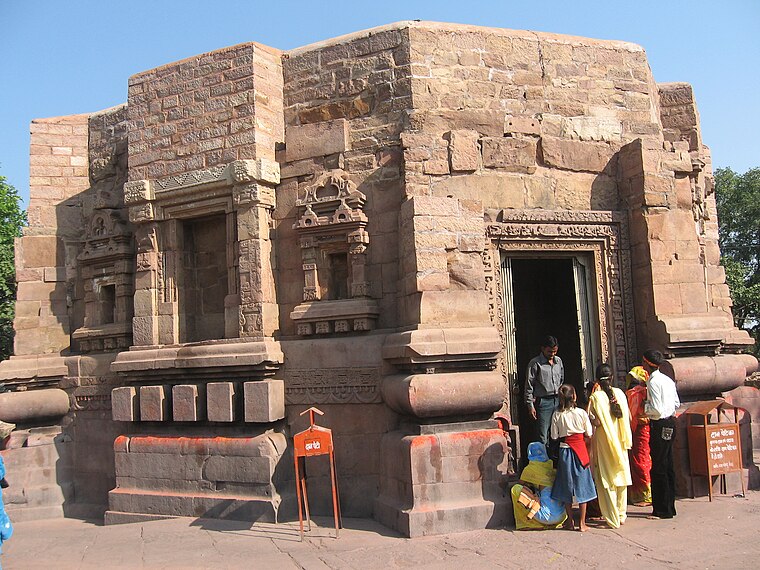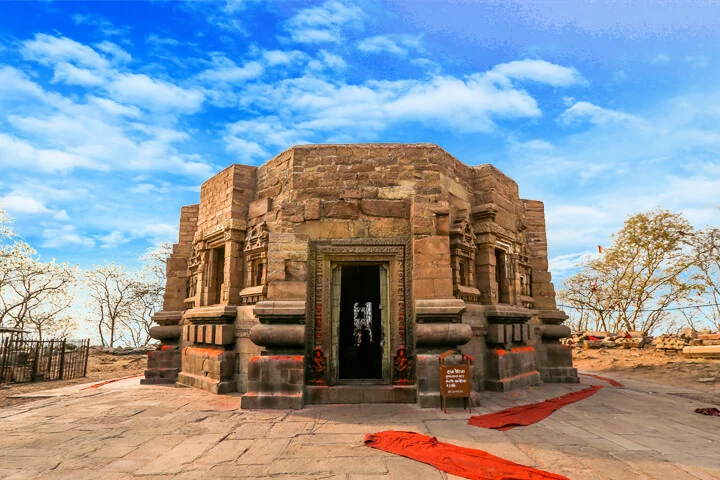
Table of Contents
Mundeshwari Temple: 1st Temple Of History
Tucked away in the tranquil Kaimur hills of Bihar, the Mundeshwari Temple stands as a testament to India’s rich spiritual heritage, offering both historical intrigue and divine energy. Regarded as one of the oldest functional temples in the world, this sacred shrine draws pilgrims, history enthusiasts, and curious travelers from all corners of India and beyond. Its origins, architectural splendor, and the cultural significance it holds make it a must-visit destination for anyone interested in exploring the deep-rooted spiritual traditions of India. In this blog, we will take a deeper look at the fascinating history, stunning architecture, spiritual significance, legends, and festivals that make Mundeshwari Temple a place of timeless devotion.
A Glimpse into History: The Origins of Mundeshwari Temple
Mundeshwari Temple’s history traces back to approximately 108 AD, making it over 1900 years old. This makes it not only one of the oldest temples in India but also one of the oldest continuously functioning temples in the world. The temple’s rich past can be seen in the inscriptions found within its precincts, most notably in Brahmi script, which indicates that it has served as a site of worship for nearly two millennia.
Belonging to the Gupta period—a time celebrated for its advancements in art, architecture, and culture—the temple is considered a significant link to the religious and cultural developments of ancient India. The temple is dedicated to two deities: Goddess Mundeshwari Devi, a powerful form of Shakti (divine feminine energy), and Lord Shiva, represented here in the form of a Shiva Linga. This dual worship of the Goddess and Lord Shiva reflects the harmonious blend of both Vaishnavite and Shaivite traditions, highlighting the inclusive nature of Indian spirituality.
Scholars and historians believe that the Mundeshwari Temple reflects the religious atmosphere of its time and remains a testament to the enduring faith of countless generations who have revered this sacred site. Over centuries, the temple has faced natural calamities and invasions but has continued to thrive, making it a living witness to India’s deep-rooted spiritual practices.
Architectural Beauty: A Masterpiece of Ancient Craftsmanship
The Mundeshwari Temple is a stunning example of the Nagara style of temple architecture. Despite the passage of centuries, the temple’s beauty has withstood the ravages of time, and much of its intricate design still remains intact. Built with locally sourced stone, the temple exhibits the extraordinary craftsmanship that was characteristic of the Gupta era.
One of the unique features of this temple is its octagonal shape—an architectural innovation that sets it apart from the typical square or rectangular temples found in other parts of India. This rare structure reflects the creative spirit of ancient Indian architects, who often sought to break free from conventional designs to create something distinct.
Noteworthy Architectural Features:
- The Octagonal Design: The octagonal shape of the temple is both a functional and aesthetic marvel, signifying a departure from the conventional styles of temple design at the time.
- Carvings and Sculptures: As you walk around the temple, you’ll notice the intricacy of the carvings that adorn the walls. These carvings depict various deities, mythological stories, and floral motifs that are visually stunning and narratively rich. Each carving seems to tell its own story, drawing visitors into the spiritual world of ancient India.
- The Sanctum: The central sanctum houses the Shiva Linga and the idol of Goddess Mundeshwari, both radiating an aura of divine energy. The sanctum’s serene atmosphere invites visitors to pause and reflect, fostering a deep spiritual connection.
- Votive Offerings and Smaller Shrines: The temple grounds are dotted with smaller shrines and offerings left by devotees, emphasizing the temple’s continued importance as a place of devotion and prayer. These offerings also include symbolic acts of faith, such as rice, flowers, and fruits, which connect the present with the deep-rooted traditions of the past.
Spiritual Significance: The Essence of Mundeshwari Temple
Mundeshwari Temple holds deep spiritual significance, not just for its architectural marvel but also for its role in the lives of those who visit it. The dual worship of Goddess Mundeshwari Devi and Lord Shiva symbolizes the union of Shakti (the feminine principle) and Shiva (the masculine principle)—a sacred balance that is revered in Indian spirituality. This representation of both divine energies attracts a diverse range of devotees who seek blessings for various aspects of life, such as health, wealth, success, and protection.
Goddess Mundeshwari Devi is particularly revered as a divine protector—one who shields her devotees from evil forces. She is also believed to be a grantor of wishes, and many visit the temple to seek her blessings for family welfare, prosperity, and spiritual growth. The worship of Lord Shiva, as the embodiment of both creation and destruction, adds to the temple’s allure as a place where one can seek inner peace and liberation (moksha).
Another distinctive practice at the temple is the tradition of symbolic animal sacrifice known as Bali. While animal sacrifices were once a part of the ritual offerings, today, the practice has evolved. Instead of sacrificing live animals, devotees offer rice, vegetables, and other symbolic items, reflecting the changing spiritual sensibilities of the times.
Legends and Myths: The Mystical Tales of Mundeshwari
Like many ancient temples, Mundeshwari Temple is surrounded by fascinating legends that add to its mystique. One such legend tells the story of the temple’s creation. It is believed that two demons, Chand and Mund, once terrorized the region. The locals were helpless in the face of the demons’ wrath, but Goddess Mundeshwari appeared in the form of a powerful deity and vanquished them. In her honor, the temple was built, standing as a symbol of victory over evil forces and a divine protection for the people.

Another significant legend tied to the temple is its association with the Navratri festival, a celebration of the triumph of good over evil. During this time, devotees gather in large numbers to offer prayers, perform rituals, and seek blessings from the Goddess. The temple, reverberating with chants and prayers, becomes a beacon of spiritual energy and devotion.
Festivals and Celebrations: A Time of Joy and Reverence
Mundeshwari Temple is particularly vibrant during major Hindu festivals, especially Navratri. Celebrated twice a year, Navratri brings together thousands of devotees who come to the temple to partake in rituals, offer prayers, and celebrate the Goddess. The temple is alive with energy, with chants, music, and vibrant processions filling the air.
Other major festivals celebrated here include:
- Shivratri: A festival dedicated to Lord Shiva, Shivratri is marked by night-long vigils, prayers, and special rituals performed in the temple. Devotees fast and stay awake through the night, offering prayers to seek the Lord’s blessings.
- Vijayadashami (Dussehra): A grand celebration that symbolizes the victory of good over evil, Vijayadashami is celebrated with much grandeur at Mundeshwari Temple, attracting devotees from all over the region.
During these festivals, the temple’s ambiance becomes even more magical, offering visitors a deeply immersive cultural and spiritual experience.
How to Reach Mundeshwari Temple
The Mundeshwari Temple is located in the Kaimur district of Bihar, making it accessible by air, train, and road. Here’s how you can reach this sacred site:
- By Air: The nearest airport is Lal Bahadur Shastri International Airport in Varanasi, located approximately 140 km away from the temple.
- By Train: The nearest railway station is Mohania, about 20 km from the temple.
- By Road: Regular buses and taxis connect the temple to nearby cities such as Bhabua, Mohania, and Varanasi. Once you reach the base of the hill, you can enjoy a short trek up to the temple, which provides beautiful views of the surrounding landscape.
The short trek adds a touch of adventure to the journey, allowing visitors to appreciate the natural beauty of the area before reaching the temple.
Tips for Visitors
- Best Time to Visit: The best time to visit Mundeshwari Temple is during the festivals of Navratri and Shivratri, when the temple is at its most vibrant and celebratory.
- Dress Modestly: As the temple is a sacred place of worship, visitors should dress modestly out of respect for its sanctity.
- Essentials to Bring: Make sure to carry water, snacks, and comfortable footwear for the trek. The journey can be physically demanding, so be prepared.
- Respect Rituals: While photography is permitted, be mindful of the rituals and try not to disrupt the sanctity of religious ceremonies.
Preservation Efforts: Keeping the Legacy Alive
The Archaeological Survey of India (ASI) has played an essential role in preserving Mundeshwari Temple. Restoration efforts have been ongoing to ensure that the temple remains a living heritage site for future generations. The local community, along with pilgrims, continues to maintain the temple’s sacred traditions. Guided tours, cultural programs, and educational initiatives have been implemented to raise awareness about the temple’s historical and spiritual significance.

Conclusion: A Journey Like No Other
Mundeshwari Temple is not just an ancient monument; it is a living embodiment of India’s rich spiritual and cultural heritage. From its awe-inspiring architecture to its profound spiritual significance and vibrant festivals, the temple offers an experience unlike any other. Whether you are a seeker of divine blessings, a lover of history, or simply someone who enjoys exploring serene landscapes, Mundeshwari Temple is a place you will not forget.
Plan your visit to this timeless treasure and let it captivate your soul with its beauty, history, and spirituality.
FAQs About Mundeshwari Temple
Q1: What makes Mundeshwari Temple significant?
Mundeshwari Temple is significant due to its age, with over 1900 years of history, making it one of the oldest functioning temples in the world. It is dedicated to Goddess Mundeshwari Devi, a form of Shakti, and Lord Shiva, symbolizing the harmonious blend of both Vaishnavite and Shaivite traditions. The temple’s unique architecture and historical inscriptions also contribute to its cultural and spiritual importance.
Q2: How old is Mundeshwari Temple?
The temple dates back to around 108 AD, making it nearly 1900 years old. It holds the distinction of being one of the oldest continuously functioning temples in the world.
Q3: What is the best time to visit Mundeshwari Temple?
The best time to visit Mundeshwari Temple is during the festivals of Navratri (celebrated twice a year) and Shivratri, when the temple comes alive with devotion, rituals, and celebrations.
Q4: Is trekking required to reach the temple?
Yes, visitors need to trek a short distance up the hill to reach the temple. The trek is scenic and offers beautiful views of the surrounding area, making the journey part of the experience.
Q5: Are animal sacrifices performed at Mundeshwari Temple?
In the past, animal sacrifices were a part of the temple rituals, but today, only symbolic sacrifices involving rice, vegetables, and other offerings are practiced. This shift reflects modern spiritual sensibilities while maintaining the tradition of devotion.
Q6: How do I reach Mundeshwari Temple?
The temple is located in the Kaimur district of Bihar. The nearest airport is Lal Bahadur Shastri International Airport in Varanasi, about 140 km away. The nearest railway station is Mohania, about 20 km from the temple. You can also travel by road from nearby cities like Bhabua, Mohania, and Varanasi.
Q7: What should I bring when visiting the temple?
It is recommended to bring water, snacks, and comfortable shoes for the trek. Additionally, dressing modestly is important out of respect for the temple’s sanctity.
Q8: Are there any preservation efforts in place for the temple?
Yes, the Archaeological Survey of India (ASI) is responsible for preserving the temple. Restoration efforts are ongoing to protect its structure and historical significance for future generations. The local community also plays an important role in maintaining the temple’s spiritual traditions.